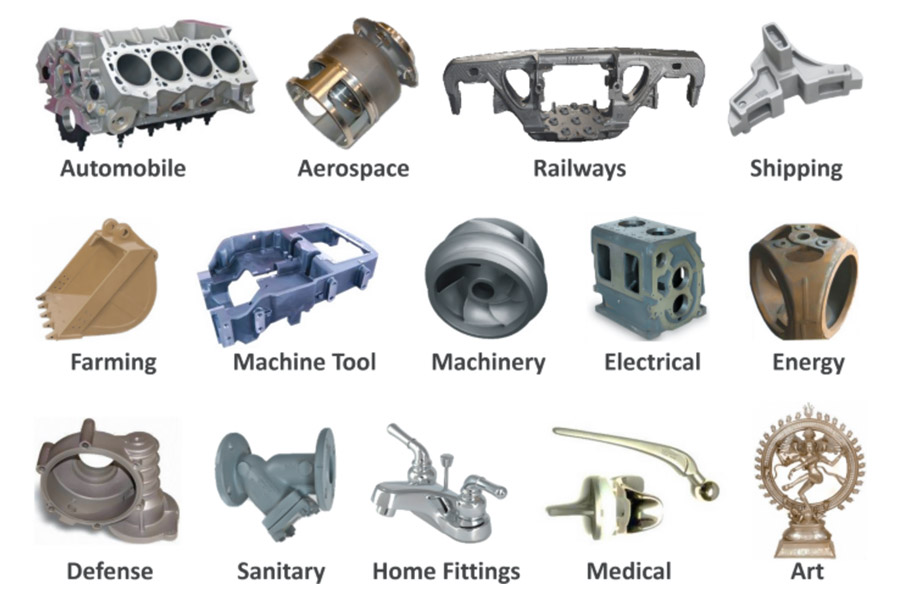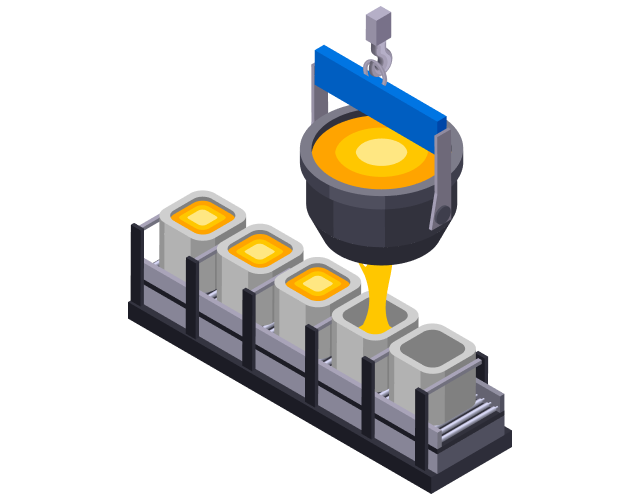Learn how Aluminum Castings enable lightweight manufacturing solutions
Wiki Article
The Role of Metal Casting beforehand Production Technologies
Metal Casting have actually especially affected the development of making modern technologies. They provide one-of-a-kind design versatility, allowing the development of complex geometries necessary for various applications. Modern casting methods are being boosted by innovations like 3D printing and automation. These advancements not just improve efficiency yet also address challenges in accuracy and sustainability. As markets proceed to progress, the function of Metal Casting remains vital fit their future. What exists ahead in this dynamic field?The Development of Steel Casting Methods
As the demand for precision and effectiveness in manufacturing has expanded, the evolution of Metal Casting strategies has actually undergone substantial makeover. Historically, Metal Casting began with easy approaches such as sand spreading and lost-wax spreading, which permitted artisans to develop detailed shapes. Gradually, advancements in modern technology introduced processes like die spreading and investment casting, boosting accuracy and minimizing waste. Aluminum Foundry. The intro of computer-aided style (CAD) and simulation software program transformed the drawing board, enabling manufacturers to anticipate possible problems and maximize designs prior to production. In addition, the growth of new materials, such as advanced alloys and composites, has actually broadened the range of applications for Metal Casting. Automation and robotics have further polished spreading processes, boosting consistency and effectiveness. Consequently, the Metal Casting sector has actually adjusted to fulfill the requirements of modern manufacturing, focusing on sustainability and development to remain competitive in an ever-evolving marketplace
Applications of Metal Casting in Secret Industries
The improvements in Metal Casting techniques have opened a wide array of applications throughout different industries. In the vehicle sector, Metal Casting are indispensable for creating engine blocks, transmission real estates, and various other important components that call for high stamina and resilience. The aerospace industry utilizes castings for complex components like generator blades and structural components, making sure lightweight yet robust solutions for airplane.
Moreover, the construction sector employs Metal Casting for architectural components such as beam of lights and fittings, adding to the honesty of buildings and facilities. In the power industry, castings play a crucial role in producing elements for wind generators and power generation tools, enhancing performance and dependability. Additionally, the medical field benefits from accuracy castings utilized in medical tools and prosthetics, demonstrating the adaptability of Metal Casting throughout diverse applications. This wide application emphasizes the value of Metal Casting in modern manufacturing practices.
Advantages of Metal Casting in Modern Production
Metal Casting offer various advantages that substantially enhance contemporary production processes. One essential advantage is layout versatility; Metal Casting enables for the creation of complicated forms and intricate geometries that are difficult or typically difficult to achieve with various other producing techniques. This capability allows manufacturers to enhance item layouts for functionality and performance.In addition, Metal Casting can support a variety of materials, including steel, aluminum, and iron, which can be tailored to satisfy details mechanical residential or commercial properties and rust resistance demands.

Cost-effectiveness is an additional remarkable benefit; Metal Casting processes can produce big quantities of get rid of minimal product waste, thereby decreasing production costs.
In addition, the resilience of cast metal parts adds to the durability of items, decreasing the requirement for frequent replacements. On the whole, the benefits of Metal Casting significantly contribute to effectiveness, sustainability, and advancement within contemporary production atmospheres.
Innovations Driving the Future of Metal Casting
While standard Metal Casting methods have served the industry well for decades, recent technologies are positioned to reinvent the field. Advancements such as 3D printing technology allow for fast prototyping and the manufacturing of intricate geometries that were formerly unattainable. These developments not just boost style versatility but likewise reduce waste and shorten preparations. On top of that, the integration of automation and robotics in casting procedures is enhancing operations, boosting precision, and boosting worker safety and security. Moreover, the advancement of brand-new alloys and composite products is enabling the development of stronger, lighter spreadings tailored for certain applications. Digital modern technologies, consisting of expert system and artificial intelligence, are enhancing casting specifications and predictive upkeep, driving improved quality assurance. Jointly, these innovations are pushing the boundaries of Metal Casting, promoting greater efficiency and sustainability in manufacturing, and positioning the sector for future growth and competition.Obstacles and Solutions in Metal Casting Processes
As developments in Metal Casting modern technology continue to improve the industry, various difficulties stay that suppliers must deal with to fully leverage these developments. One considerable problem is the variability in product properties, which can cause inconsistent high quality and efficiency. This irregularity typically results from changes in resources and processing problems. Additionally, the increasing prices of energy and products present financial constraints, pushing producers to look for much more efficient processes.To combat these obstacles, firms are progressively embracing automated systems and progressed simulation strategies to boost precision and uniformity. Executing quality assurance actions throughout the manufacturing process additionally assists in detecting problems early. Moreover, spending in research for alternate products may lower expenses and improve sustainability. By attending to these challenges with innovative remedies, the Metal Casting sector can enhance efficiency and maintain competition in the advancing production landscape.
Often Asked Concerns
What Products Are Commonly Used in Metal Casting Processes?
Usual products used in Metal Casting processes consist of aluminum, magnesium, bronze, and iron. Each product has unique properties that accommodate various applications, boosting the convenience and capability of the final cast products in different industries.Exactly How Do Ecological Rules Effect Metal Casting Operations?
Environmental regulations force Metal Casting procedures to embrace cleaner methods and technologies, often increasing manufacturing costs. Compliance may bring about ingenious processes that reduce waste and discharges, eventually advertising sustainability within the Metal Casting sector.What Are the Safety And Security Measures in Metal Casting Facilities?
Safety actions in Metal Casting centers include correct ventilation, personal protective equipment, routine safety and security training, tools maintenance, and adherence to security guidelines, making sure a secure setting for employees while reducing dangers linked with unsafe materials and processes.Just How Is High quality Controlled in the Metal Casting Refine?
Quality control in Metal Casting includes strenuous inspections, including aesthetic assessments, dimensional checks, and product screening. Adherence to industry requirements and implementing high quality administration systems ensures that spreadings satisfy given demands throughout the production process.
What Is the Future Task Outlook for Metal Casting Professionals?
The future work overview for Metal Casting professionals shows up encouraging, driven by developments in innovation and enhancing demand throughout various sectors (Wisconsin Aluminum Foundry). Development in automation and sustainable methods will likely create brand-new chances in this marketHistorically, Metal Casting began with straightforward methods such as sand casting and lost-wax spreading, which enabled artisans to produce detailed forms. Over time, developments Wisconsin Aluminum Foundry in technology introduced processes like die casting and financial investment casting, enhancing accuracy and lowering waste. In addition, the medical area advantages from accuracy castings utilized in surgical instruments and prosthetics, demonstrating the flexibility of Metal Casting throughout diverse applications. Metal Casting offer numerous benefits that significantly boost contemporary production processes. Typical materials used in Metal Casting processes include light weight aluminum, bronze, iron, and magnesium.
Report this wiki page